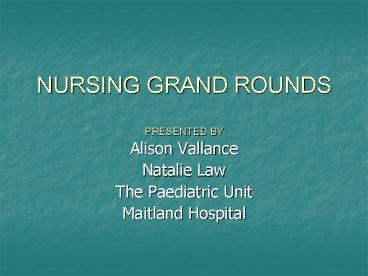NURSING GRAND ROUNDS PRESENTED BY - PowerPoint PPT Presentation
1 / 26
Title:
NURSING GRAND ROUNDS PRESENTED BY
Description:
'Child abuse and neglect consists of an act of commission or omission that ... R leg abducted and shortened. Bruising to Knee. Facial bruising. Abrasions to mouth. ... – PowerPoint PPT presentation
Number of Views:1975
Avg rating:3.0/5.0
Title: NURSING GRAND ROUNDS PRESENTED BY
1
NURSING GRAND ROUNDSPRESENTED BY
- Alison Vallance
- Natalie Law
- The Paediatric Unit
- Maitland Hospital
2
Non- accidental InjuryMeningococcal Meningitis
- Good observation skills.
- Accurate documentation.
- Relevance of procedures and protocols.
3
Non- accidental Injury
- What constitutes abuse?
- General and specific indicators for abuse.
- Health professionals response.
4
Child abuse and neglect consists of an act of
commission or omission that endangers or impairs
a childs physical and or emotional development
- Physical Abuse
- Sexual Abuse
- Emotional or Psychological Abuse.
- Neglect.
5
Physical Abuse
- Excessive discipline.
- Severe beatings.
- Shaking.
- Cigarette burns.
- Strangulations.
- Female genital mutilations.
- Bruising.
- Lacerations.
- Burns.
- Fractures or dislocations.
- Head injuries.
- Internal injuries.
6
- History of previous harm.
- Social or geographical isolation.
- Abuse of neglect of sibling.
- Domestic violence.
- Substance abuse.
- Functional parenting deficiency.
- Behaviour management problems.
- Unrealistic expectations.
7
General Indicators.
- Conflicting accounts of injury.
- Child discloses.
- Family or friend discloses suspected abuse.
- Poor concentration.
- Sleeping problems.
- Sudden behaviour changes.
- Unexplained illnesses, headaches etc.
8
Specific Indicators in the Child
- Facial, head neck bruising.
- Welts or lacerations.
- Inconsistent explanation.
- Marks or bruising showing shape of object.
- Bite marks.
- Multiple injuries.
- Bruising of differing ages.
- Ingestion of poisons, alcohol other drugs.
- Fractures or dislocations under 3 years.
- Burns and scalds.
- Head injury in the non-mobile child.
9
Specific Parental Indicators
- Direct admission.
- Family history of violence.
- Past history of own maltreatment.
- Repeated presentations.
- Marked delay.
- Inconsistent account of events or cause of injury.
10
Response
- Under the Children and Young Persons (Care and
Protection) Act. - DoCS notification.
- Helpline 24/7
- Faxed report . Risk of Harm.
- Emergency Pager or 000.
11
Annas Story
- 2 years.
- Referred to local hospital from Child health
nurse. - Night terrors.
- O/A at 4pm.
- Multiple facial bruising.
- Abrasions to abdomen, R thigh and arm.
- Obs stable.
- Wgt. (3rd Percentile) Ht. 75th .
- Reports thrashing, screaming and biting self.
- Referred to Maitland
- Arrived Maitland 1913.
- Alert, interactive.
- Paediatric review.
- Admitted for observation Paediatric Unit 2240hrs.
- Difficult to settle but uneventful night.
- Reviewed by Paediatrician in am.
- Abdominal bruises.
- Bruises to forehead.
- Inconsistent bite mark.
- Bruising L scapula.
12
Social History
- Anna lives with mother and fiancé.
- Visits father 2 out of 3 weekends.
- Paternal Gparents overseas.
- Maternal Gparents interstate.
- Moved.
- No other siblings.
- Recently Anna wary of fiancé.
13
- Discharged 4 days later into mothers care.
- Ophthalmology, head CT and bloods normal.
- Bone scan Increased uptake L scapula.
- Skeletal survey normal.
- No concerns re. growth.
- Discharge plan
- Review Maitland Paediatrician 2 weeks
- Home visit Child Protection Team.
- Community Health.
- Child Protection Team at JHCH notified.
- DoCS notification.
- Bloods.
- Cranial CT.
- Ophthalmology review.
- Transfer.
14
2nd Presentation.
- 2 weeks later.
- O/A
- Nausea vomiting.
- Reluctant to move R arm or R leg.
- Facial bruising to L eye.
- Bloods unremarkable.
- Transferred to Maitland.
15
Clinical Findings
- Pale and lethargic.
- Unable to lift arm.
- R leg abducted and shortened.
- Bruising to Knee.
- Facial bruising.
- Abrasions to mouth.
- NO history of trauma.
- NO explanation.
- NO recent visits.
- ENT and Abdo NAD.
16
Radiological Findings
- R Humerus
- R Distal radius
- R proximal tibia.
- Admitted to Paed. Unit 0030hrs.
- IV fluids.
- Analgesia.
- Bed rest.
- Cares by Nursing Staff.
- DoCS notification in am.
17
- Transferred to JHCH next day.
- Bone scan reveals.
- R Humerus
- R distal radius
- R ulna
- Tip R scapula
- L midshaft ulna.
- R distal femur
- R proximal tib/fib.
18
Where did we go wrong?
- How could this have been prevented?
- Whats the use?
19
What was done correctly?
- Identification of indicators
- Facial bruising
- Night terrors
- Inconsistent bite mark.
- Combative.
- Mothers concerns.
- Isolated.
- Appropriate Action.
- Referral.
- JHCH child protection team.
- DoCS notification.
- Discharge follow up.
- Baselines established.
- History established.
20
Observations/ Documentation.
- Full repeated OBs.
- Nursing History.
- Sequence of events.
- Appropriate documentation
21
(No Transcript)
22
- Thankyou
- Any questions?
23
References NSW Health Intranet. Child
Protection. NSW Department of Community Services
Website www.community.nsw.gov.au/preventing child
abuse and neglect. Child Safety
Australia www.childsafetyaustralia.com.au
24
(No Transcript)
25
(No Transcript)
26
(No Transcript)

